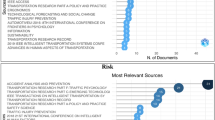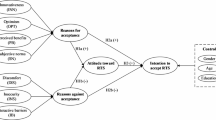Abstract
Different theories, models and frameworks have been used to study technology adoption, some explaining the determinants of adoption at the individual level, some at the organizational level and some at both. As Artificial Intelligence (AI) is gaining traction in many sectors, it will be beneficial to understand the determinants and barriers to AI adoption. In this paper, an attempt has been made to review journal articles and other reports pertaining to AI adoption and understand the adoption theories used and the factors that facilitate and those that hinder AI adoption. Articles on adoption studies of autonomous vehicles, big data analytics, robots and cognitive engagement applications dominated the list of journal articles. Diffusion of Innovation, Technology, Organization and Environment Framework and the unified theory of acceptance and use of technology (UTAUT) were some of the dominant theories/frameworks used. Factors influencing adoption at the individual level were related to trust, security, purchase price, intrinsic motivation, social influence, utilitarian benefit whereas at the organizational level, it was related to the technical competencies, strategic road mapping for AI, top management support and the digital maturity of the organization.
Access this chapter
Tax calculation will be finalised at checkout
Purchases are for personal use only
Similar content being viewed by others
References
Adnan, N., Nordin, S.M., bin Bahruddin, M.A., Ali, M.: How trust can drive forward the user acceptance to the technology? In-vehicle technology for autonomous vehicle. Transp. Res. Part A: Policy Pract. 118, 819–836 (2018)
Androutsopoulou, A., Karacapilidis, N., Loukis, E., Charalabidis, Y.: Transforming the communication between citizens and government through AI-guided chatbots. Gov. Inf. Q. 36(2), 358–367 (2019)
Baig, M.I., Shuib, L., Yadegaridehkordi, E.: Big data adoption: state of the art and research challenges. Inf. Process. Manag. 56(6), 102095 (2019)
Bawack, R.E., Kamdjoug, J.R.K.: Adequacy of UTAUT in clinician adoption of health information systems in developing countries: the case of Cameroon. Int. J. Med. Inform. 109, 15–22 (2018)
Berliner, R.M., Hardman, S., Tal, G.: Uncovering early adopter’s perceptions and purchase intentions of automated vehicles: insights from early adopters of electric vehicles in California. Transp. Res. Part F: Traffic Psychol. Behav. 60, 712–722 (2019)
Carreiro, H., Oliveira, T.: Impact of transformational leadership on the diffusion of innovation in firms: application to mobile cloud computing. Comput. Ind. 107, 104–113 (2019)
Chakravarty, S., Dubinsky, A.: Individual investors’ reactions to decimalization: innovation diffusion in financial markets. J. Econ. Psychol. 26(1), 89–103 (2005)
Chen, S., Wang, H., Meng, Q.: Designing autonomous vehicle incentive program with uncertain vehicle purchase price. Transp. Res. Part C: Emerg. Technol. 103, 226–245 (2019)
Cruz-Jesus, F., Pinheiro, A., Oliveira, T.: Understanding CRM adoption stages: empirical analysis building on the TOE framework. Comput. Ind. 109, 1–13 (2019)
Cunningham, M.L., Regan, M.A., Horberry, T., Weeratunga, K., Dixit, V.: Public opinion about automated vehicles in Australia: results from a large-scale national survey. Transp. Res. Part A: Policy Pract. 129, 1–18 (2019)
Du, N., et al.: Look who’s talking now: implications of AV’s explanations on driver’s trust, AV preference, anxiety and mental workload. Transp. Res. Part C: Emerg. Technol. 104, 428–442 (2019)
Fan, W., Liu, J., Zhu, S., Pardalos, P.M.: Investigating the impacting factors for the healthcare professionals to adopt artificial intelligence-based medical diagnosis support system (AIMDSS). Ann. Oper. Res. 1–26 (2018)
Ghobakhloo, M., Ching, N.T.: Adoption of digital technologies of smart manufacturing in SMEs. J. Ind. Inf. Integr. 16, 100107 (2019)
Gursoy, D., Chi, O.H., Lu, L., Nunkoo, R.: Consumers acceptance of artificially intelligent (AI) device use in service delivery. Int. J. Inf. Manag. 49, 157–169 (2019)
Hoque, R., Sorwar, G.: Understanding factors influencing the adoption of mHealth by the elderly: an extension of the UTAUT model. Int. J. Med. Inform. 101, 75–84 (2017)
Kamal, S.A., Shafiq, M., Kakria, P.: Investigating acceptance of telemedicine services through an extended technology acceptance model (TAM). Technol. Soc. 60, 101212 (2020)
Lai, Y., Sun, H., Ren, J.: Understanding the determinants of big data analytics (BDA) adoption in logistics and supply chain management. Int. J. Logist. Manag. (2018)
Lakshmi, V., Bahli, B.: Understanding the robotization landscape transformation: a centering resonance analysis. J. Innov. Knowl. 5(1), 59–67 (2020)
Latikka, R., Turja, T., Oksanen, A.: Self-efficacy and acceptance of robots. Comput. Hum. Behav. 93, 157–163 (2019)
Lee, Y.C., Mirman, J.H.: Parents’ perspectives on using autonomous vehicles to enhance children’s mobility. Transp. Res. Part C: Emerg. Technol. 96, 415–431 (2018)
Liu, P., Guo, Q., Ren, F., Wang, L., Xu, Z.: Willingness to pay for self-driving vehicles: influences of demographic and psychological factors. Transp. Res. Part C: Emerg. Technol. 100, 306–317 (2019)
Liu, Z., Zhu, L., Roberts, R., Tong, W.: Toward clinical implementation of next generation sequencing-based genetic testing in rare diseases: where are we?. Trends Genet. (2019)
Lu, L., Cai, R., Gursoy, D.: Developing and validating a service robot integration willingness scale. Int. J. Hospital. Manag. 80, 36–51 (2019)
Luo, Q., Saigal, R., Chen, Z., Yin, Y.: Accelerating the adoption of automated vehicles by subsidies: a dynamic games approach. Transp. Res. Part B: Methodol. 129, 226–243 (2019)
Magsamen-Conrad, K., Upadhyaya, S., Joa, C.Y., Dowd, J.: Bridging the divide: using UTAUT to predict multigenerational tablet adoption practices. Comput. Hum. Behav. 50, 186–196 (2015)
Manis, K.T., Choi, D.: The virtual reality hardware acceptance model (VR-HAM): extending and individuating the technology acceptance model (TAM) for virtual reality hardware. J. Bus. Res. 100, 503–513 (2019)
McLean, G., Osei-Frimpong, K.: Hey Alexa… examine the variables influencing the use of artificial intelligent in-home voice assistants. Comput. Hum. Behav. 99, 28–37 (2019)
Merfeld, K., Wilhelms, M.P., Henkel, S.: Being driven autonomously–a qualitative study to elicit consumers’ overarching motivational structures. Transp. Res. Part C: Emerg. Technol. 107, 229–247 (2019)
Montenegro, J.L.Z., da Costa, C.A., da Rosa Righi, R.: Survey of conversational agents in health. Expert Syst. Appl. (2019)
Oliveira, T., Martins, R., Sarker, S., Thomas, M., Popovič, A.: Understanding SaaS adoption: the moderating impact of the environment context. Int. J. Inf. Manag. 49, 1–12 (2019)
Sepasgozar, S.M., Hawken, S., Sargolzaei, S., Foroozanfa, M.: Implementing citizen centric technology in developing smart cities: a model for predicting the acceptance of urban technologies. Technol. Forecast. Soc. Chang. 142, 105–116 (2019)
Shabanpour, R., Golshani, N., Shamshiripour, A., Mohammadian, A.K.: Eliciting preferences for adoption of fully automated vehicles using best-worst analysis. Transp. Res. Part C: Emerg. Technol. 93, 463–478 (2018)
Shin, J., Park, Y., Lee, D.: Who will be smart home users? An analysis of adoption and diffusion of smart homes. Technol. Forecast. Soc. Chang. 134, 246–253 (2018)
Simpson, J.R., Mishra, S., Talebian, A., Golias, M.M.: An estimation of the future adoption rate of autonomous trucks by freight organizations. Res. Transp. Econ. 76, 100737 (2019)
Talebian, A., Mishra, S.: Predicting the adoption of connected autonomous vehicles: a new approach based on the theory of diffusion of innovations. Transp. Res. Part C: Emerg. Technol. 95, 363–380 (2018)
Toh, T.S., Dondelinger, F., Wang, D.: Looking beyond the hype: applied AI and machine learning in translational medicine. EBioMedicine (2019)
Van Esch, P., Black, J.S., Ferolie, J.: Marketing AI recruitment: the next phase in job application and selection. Comput. Hum. Behav. 90, 215–222 (2019)
Verma, S., Bhattacharyya, S.S.: Perceived strategic value-based adoption of big data analytics in emerging economy. J. Enterp. Inf. Manag. (2017)
Wang, Y.S., Li, H.T., Li, C.R., Zhang, D.Z.: Factors affecting hotels’ adoption of mobile reservation systems: a technology-organization-environment framework. Tour. Manag. 53, 163–172 (2016)
Wright, L.T., Robin, R., Stone, M., Aravopoulou, D.E.: Adoption of big data technology for innovation in B2B marketing. J. Bus. Bus. Mark. 26(3–4), 281–293 (2019)
Xu, J., et al.: Translating cancer genomics into precision medicine with artificial intelligence: applications, challenges and future perspectives. Hum. Genet. 138(2), 109–124 (2019)
Zhang, T., Tao, D., Qu, X., Zhang, X., Lin, R., Zhang, W.: The roles of initial trust and perceived risk in public’s acceptance of automated vehicles. Transp. Res. Part C: Emerg. Technol. 98, 207–220 (2019)
Zheng, K., et al.: Ease of adoption of clinical natural language processing software: an evaluation of five systems. J. Biomed. Inform. 58, S189–S196 (2015)
Zhu, K., Weyant, J.P.: Strategic decisions of new technology adoption under asymmetric information: a game-theoretic model. Decis. Sci. 34(4), 643–675 (2003)
Author information
Authors and Affiliations
Corresponding author
Editor information
Editors and Affiliations
Rights and permissions
Copyright information
© 2020 IFIP International Federation for Information Processing
About this paper
Cite this paper
Radhakrishnan, J., Chattopadhyay, M. (2020). Determinants and Barriers of Artificial Intelligence Adoption – A Literature Review. In: Sharma, S.K., Dwivedi, Y.K., Metri, B., Rana, N.P. (eds) Re-imagining Diffusion and Adoption of Information Technology and Systems: A Continuing Conversation. TDIT 2020. IFIP Advances in Information and Communication Technology, vol 617. Springer, Cham. https://doi.org/10.1007/978-3-030-64849-7_9
Download citation
DOI: https://doi.org/10.1007/978-3-030-64849-7_9
Published:
Publisher Name: Springer, Cham
Print ISBN: 978-3-030-64848-0
Online ISBN: 978-3-030-64849-7
eBook Packages: Computer ScienceComputer Science (R0)





